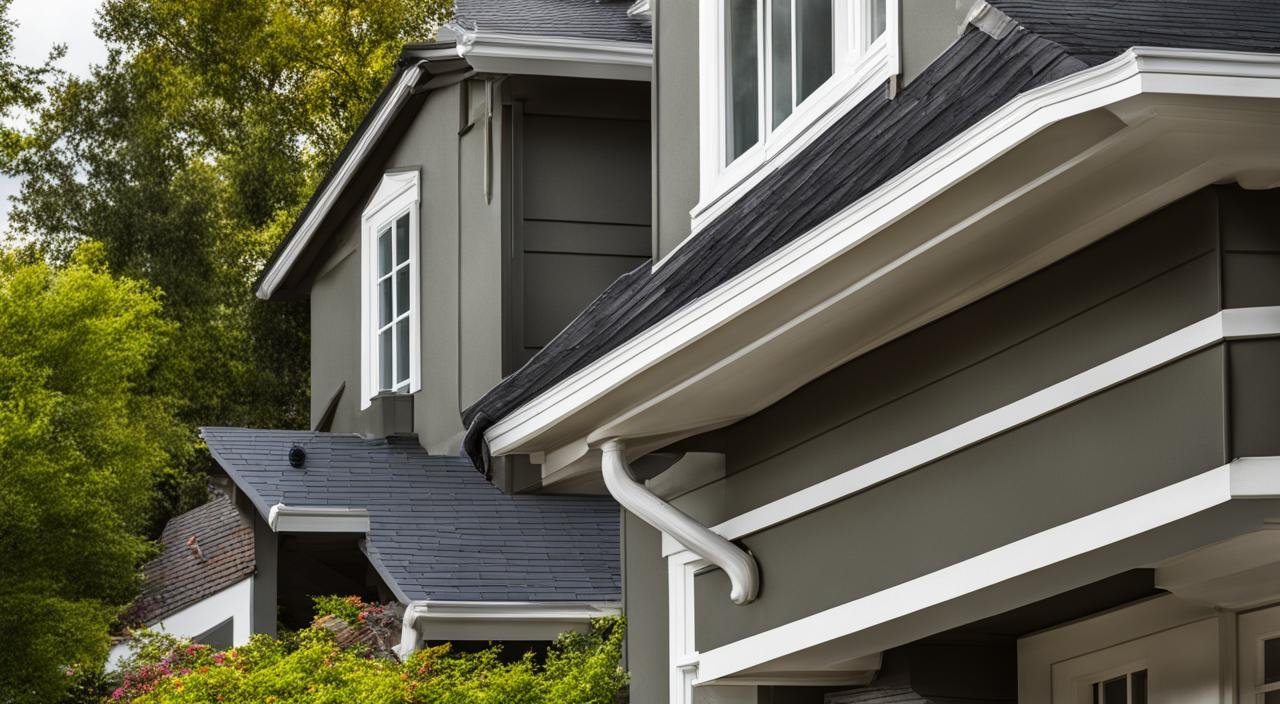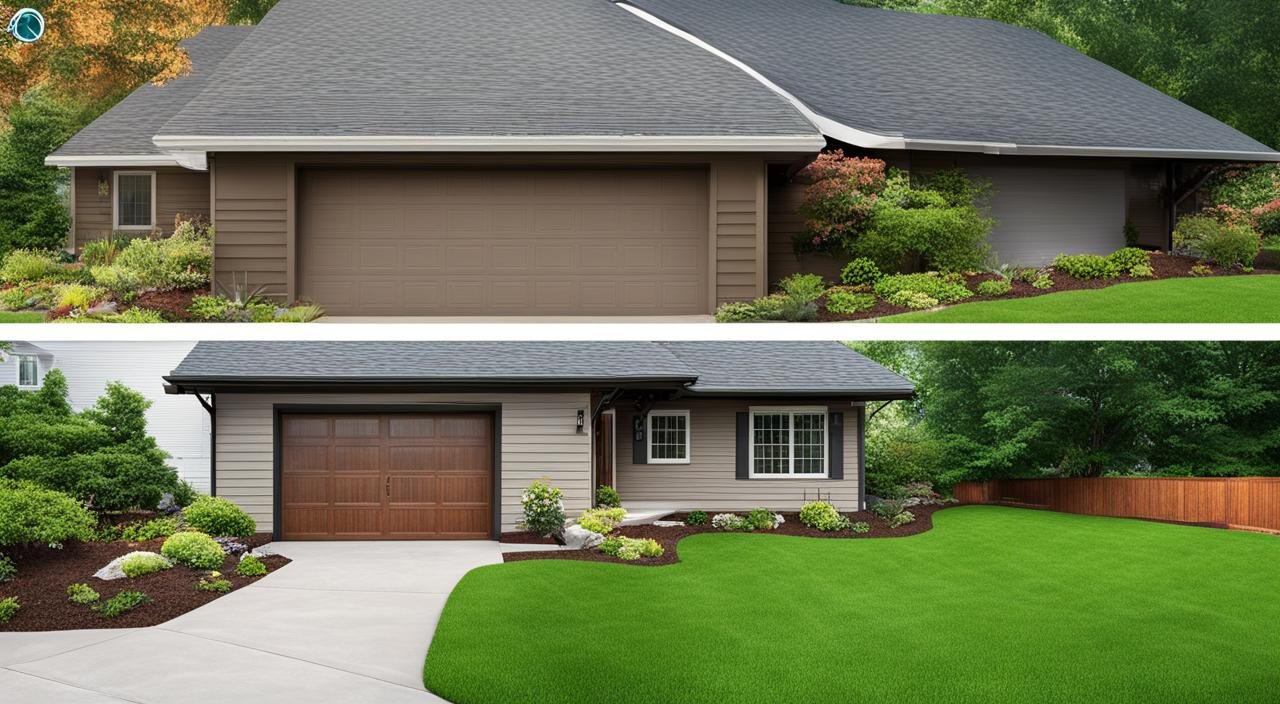Are gutters required by code? The answer is yes – gutters are often mandated by building codes and regulations in the United States. These codes exist to ensure safe and functional structures, and gutters play a critical role in protecting your property from water damage.
In this comprehensive guide, we will explore gutter regulations in the United States and explain how they impact the drainage system of your property. We will also discuss the importance of complying with local codes and guidelines, obtaining necessary permits, and hiring professionals who prioritize code compliance.
Key Takeaways:
- Building codes in the United States often require gutters to be installed on properties.
- Gutter regulations exist to ensure the safety and functionality of structures.
- Complying with local codes and guidelines, obtaining necessary permits, and hiring professionals who prioritize code compliance are critical for a successful and compliant gutter system.
Understanding Building Codes for Gutters
When it comes to installing gutters, it’s essential to understand the building codes that pertain to them. These codes are in place to ensure the safety, functionality, and longevity of the gutter system on your property. In this section, we’ll take a closer look at the gutter installation code requirements and the building code for gutters.
The building code for gutters outlines the specific requirements for their installation, including the materials used, the size of the gutters, and the placement of downspouts. These codes vary by region and are generally enforced by local building departments.
For example, according to the International Building Code (IBC), gutters should be installed to withstand the maximum expected rainfall in the region. If your area experiences heavy rains, it may require larger gutters, downspouts, or additional drainage systems to accommodate the increased water flow.
Additionally, the IBC provides guidance on the number and placement of downspouts to ensure adequate drainage and prevent water damage to the property. The codes also require that gutters are securely attached to the building to withstand high winds and heavy precipitation.
It’s important to note that building codes may change over time, and it’s crucial to stay up-to-date with any revisions or updates that may impact your gutter system.
Gutter Installation Code Requirements
When it comes to installing gutters, there are several code requirements that must be met. Contractors and homeowners must ensure that the gutters are properly installed and meet all the necessary codes outlined by the local building department. Some of the essential code requirements for gutter systems include:
- The gutters must be installed with the proper slope to ensure water flows toward the downspouts and away from the property
- The gutters must have an adequate number of downspouts to handle the amount of rainfall in the region
- The gutters must be securely attached to the building to withstand high winds and heavy precipitation
- The gutters must be made of durable materials that can withstand the elements and the test of time
Meeting these code requirements can help prevent water damage to your property and ensure that your gutters function as intended.
Local Gutter Code Requirements
When it comes to gutter code requirements, it’s essential to understand that they can vary by locality. Your specific area may have specific regulations that need to be followed to ensure compliance. Some areas may have no code at all, while others may have strict requirements regarding the installation and maintenance of gutters.
Checking with your local code official or building department can help you determine the specific gutter code requirements in your area.
Examples of Local Gutter Code Requirements
Here are some examples of common gutter code requirements in different localities:
| Location | Gutter Code Requirements |
|---|---|
| City A | All buildings must have gutters installed at a minimum of 6 feet from the foundation and be securely attached to the fascia. |
| County B | Gutters must be installed with a minimum slope of one-fourth inch per 10 feet of gutter to ensure proper drainage. |
| State C | All gutters must be made of metal, vinyl, or other approved materials and must have a minimum width of 5 inches. |
These examples showcase how specific localities have unique requirements that may differ from other areas. Familiarizing yourself with the specific requirements in your area can help ensure that your gutters are compliant with local codes.
Non-compliance with local gutter code requirements can result in fines, delays in construction, and other consequences. It’s essential to stay up-to-date with any changes or revisions to the codes to maintain compliance and functionality of your gutter system.
Next, we’ll discuss how obtaining permits can aid in your compliance with local gutter codes.

Obtaining Permits for Gutter Installation
Before installing gutters on your property, it’s essential to determine whether or not you need a building permit. Gutters and building permits often go hand in hand, as many jurisdictions require homeowners or contractors to obtain proper permits before beginning any construction projects. Failure to do so may result in fines or other legal consequences.
The specific requirements for obtaining a permit can vary depending on your location. Some areas may require detailed drawings or documentation of the proposed gutter system, while others may only require a simple application outlining the scope of the project.
To find out whether you need a permit, start by consulting your local building code office or department. They can provide you with information on the specific requirements for your jurisdiction and guide you through the permit application process. Gutters and building permits are important to consider, as non-compliance can lead to delays in construction and added expenses.
Why You Need a Permit
Building permits are designed to ensure that construction projects comply with safety and building standards established by local and national codes. Obtaining a permit for your gutter installation project is important because it:
- Ensures that your project meets local building codes and standards
- Helps to protect the safety of your property and those around it
- Provides a record of your project for future reference
- May be required for insurance or financing purposes
How to Obtain a Permit
The process for obtaining a permit for your gutter installation project can vary depending on your location. In general, it may involve the following steps:
- Contacting your local building code office or department to determine whether you need a permit
- Gathering the necessary documentation, such as detailed drawings or a project proposal
- Completing the permit application and paying any associated fees
- Scheduling any necessary inspections
- Ensuring that your project complies with all building codes and standards
It’s important to note that permits are typically required for any projects that involve altering the structural or mechanical components of a building, including the installation or replacement of gutters. While the process can be time-consuming, obtaining a permit is an essential step in ensuring the safety and compliance of your gutter installation project.
Common Gutter Code Guidelines
When it comes to designing and installing a gutter system, adhering to code guidelines is critical for ensuring proper functionality. Here are some common gutter code guidelines to keep in mind:
Design Guidelines
The design of your gutter system should ensure that all water is collected and directed away from your property’s foundation. The following design guidelines should be followed:
- Gutters should be sloped a minimum of 1/4 inch per 10 feet toward the downspout.
- Downspouts should be installed no more than 50 feet apart.
- Gutters should be installed with a minimum of 1/2 inch clearance between the drip edge and the back of the gutter.
Material Guidelines
The materials used for your gutter system can impact its durability and effectiveness. The following material guidelines should be followed:
| Material | Description |
|---|---|
| Aluminum | Lightweight, rust-resistant, and easy to install. |
| Copper | Durable, long-lasting, and adds an aesthetic appeal to your property. |
| Vinyl | Low-cost and easy to install, but less durable and can crack in extreme temperatures. |
Dimension Guidelines
The dimensions of your gutter system should be appropriate for the size of your property and the volume of water it receives. The following dimension guidelines should be followed:
- Gutters should be a minimum of 5 inches wide and 4 inches deep.
- Downspouts should be a minimum of 2×3 inches or 3 inches in diameter.
- A gutter system should have one downspout for every 30 to 40 linear feet of gutter.
By following these common gutter code guidelines, you can ensure that your gutter system is functional, durable, and compliant with building codes.
Benefits of Code Compliance for Gutters
Adhering to gutter code requirements offers several benefits for property owners. One of the most significant advantages is improved drainage, which can protect your property from water damage caused by backed-up gutters.
When gutters aren’t functioning correctly, water can seep into your home’s foundation, causing cracks and leaks. This can result in costly repairs and decreased property value. By meeting code compliance requirements for gutters, you can ensure a well-maintained drainage system that protects your property from these issues.
Another benefit of code compliance is that it reduces the risk of liability issues. If a person is injured due to water damage caused by your property’s drainage system, you may be held responsible for any resulting damages or medical expenses. Compliance with gutter regulations can help mitigate this risk.
In addition, adhering to gutter code guidelines can increase your property’s resale value. Prospective homebuyers are more likely to purchase a property with a functional and compliant gutter system in place, as it provides peace of mind that the property is well-maintained and less likely to experience water damage.
Overall, code compliance for gutters is essential for the longevity of your property and the functionality of its drainage system. By following regulations and guidelines, you can protect your property from water damage, liability issues, and maintain its value.

Consequences of Non-Compliance with Gutter Codes
Ignoring gutter regulations and failing to comply with code requirements can have dire consequences. Not only can it lead to costly fines and legal fees, but it can also result in structural damage and a decrease in property value. Maintaining code compliance for gutters is crucial to prevent water damage to your property and the surrounding areas.
“By law, homeowners are required to adhere to building codes for their properties, including gutter installations. Failure to comply can lead to legal and financial repercussions.”
Non-compliance with gutter regulations can result in fines from local or state authorities. These fines can range from a few hundred to several thousand dollars, depending on the severity of the violation. In some cases, non-compliance can also lead to the suspension of construction projects until all necessary permits are obtained and code requirements are met. This can result in costly delays and a loss of productivity for homeowners.
In addition to the financial consequences, non-compliance can also result in structural damage to your property. Improperly installed gutters can lead to water overflow and pooling, which can cause rot, mold, and other structural damage. This damage can spread to neighboring properties and lead to potential liability issues.
Finally, non-compliance can result in a decrease in property value. Insurers may refuse to cover properties that fail to comply with building codes, and prospective buyers may be deterred from purchasing a property with non-compliant gutter systems. Ensuring code compliance for gutters is essential to protect the long-term value of your property.
Don’t risk the financial, structural, and legal consequences of non-compliance with gutter regulations. Consult with professionals to ensure your gutter system is installed in compliance with building codes and maintains the safety and value of your property.
Hiring Professionals for Gutter Installation
When it comes to installing gutters, hiring professionals who are knowledgeable about gutter installation code requirements is crucial. Not only will they ensure your gutter system is compliant with local regulations, but they’ll also provide quality workmanship that lasts for years to come.
Before hiring a gutter installation professional, be sure to research their experience and qualifications. Look for contractors who have a strong reputation in the industry and are licensed and insured. You can also check for reviews and ratings from previous customers to gauge their level of customer service and satisfaction.
When discussing your gutter installation project with potential contractors, ask about their approach to code compliance. A reputable professional will prioritize adhering to all necessary regulations and guidelines, and will be able to explain the specific requirements for your area.
By working with a skilled and knowledgeable professional, you can ensure that your gutter installation meets all necessary code requirements and will function properly for years to come.
Remember, investing in a compliant gutter system now can save you from costly repairs and water damage in the future.
Staying Up-to-Date with Gutter Code Changes
Keeping up-to-date with gutter code regulations is crucial to ensure compliance and maintain a functional drainage system. You must stay informed about any updates or revisions to gutter codes to ensure ongoing compliance and the longevity of your gutter system.
One way to stay on top of gutter code changes is by subscribing to industry publications or newsletters. You can also consult with local building authorities to learn about any changes or updates to gutter codes in your area.
It’s essential to keep in mind that failure to comply with gutter codes can have serious consequences. By staying up-to-date with the latest regulations and guidelines, you can protect your property from water damage and avoid any potential liabilities.
Consult with Professionals
If you’re unsure about the compliance of your gutter system with the latest building codes, it’s best to consult with professionals. Experienced contractors can help you assess the compliance of your existing gutter system and ensure that any updates or repairs are in-line with the latest gutter code regulations.
Professional contractors prioritize code compliance when installing, repairing, or upgrading gutter systems. They have in-depth knowledge of the latest gutter code guidelines and understand the importance of staying up-to-date with any changes or updates.
Conclusion
Ensuring compliance with building codes for gutters is essential for protecting your property and maintaining its value. By understanding the regulations and guidelines related to gutter installation, you can avoid potential fines and liability issues. Remember to consult your local requirements and work with reputable professionals who prioritize compliance with gutter installation code requirements.
Staying up-to-date with any changes or revisions to gutter regulations is critical for ongoing compliance and the longevity of your gutter system. Make sure to follow common gutter code guidelines related to design, material, and dimension to ensure your installation meets all necessary requirements.
Non-compliance with gutter codes can have severe consequences, including delays in construction projects and potential water damage to your property. Hiring professionals who are knowledgeable about gutter installation code requirements is essential for a successful and compliant gutter system.
By following the building codes and regulations set forth for gutters, you can enjoy the benefits of improved drainage and reduced risk of water damage to your property. Remember, compliance with gutter code regulations is crucial for a functional and compliant drainage system.

